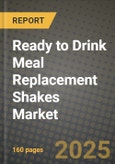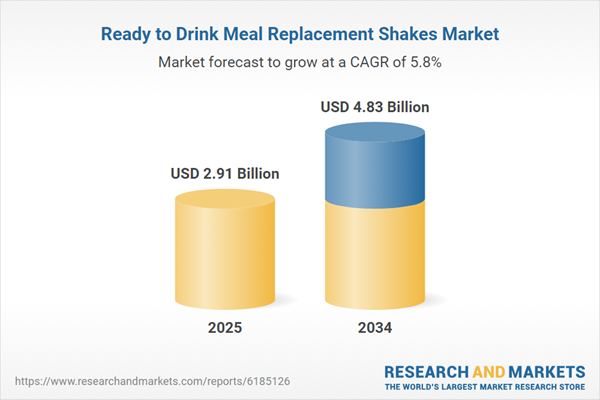Ready to Drink Meal Replacement Shakes Market
The Ready to Drink (RTD) Meal Replacement Shakes market sits at the intersection of convenience nutrition, functional beverages, and lifestyle wellness. Products are designed to deliver balanced macros and micronutrients in a shelf-stable, single-serve format, addressing use cases from on-the-go breakfast and weight management to sports recovery, clinical/elderly nutrition, and appetite control during busy workdays. Core end-uses include retail take-home, workplace and campus vending, fitness and specialty nutrition stores, hospital and pharmacy channels, and increasingly foodservice and delivery platforms. Category evolution is shaped by three forces: cleaner labels (lower sugar, fewer additives, recognizable ingredients), functional stacking (high-quality protein, fiber/prebiotics, MCTs, omega-3s, probiotics, collagen, adaptogens, and nootropics), and inclusivity (plant-based, lactose-free, gluten-free, diabetic-friendly, keto-aligned). Packaging advances - primarily aseptic cartons and PET/aluminum options with improved barrier layers - extend shelf life while supporting sustainability narratives. Go-to-market is omnichannel: mass and specialty retail anchor scale, while DTC subscriptions, marketplace storefronts, and creator-led social commerce drive trial and loyalty. Competitive dynamics feature a blend of global medical/clinical nutrition incumbents, active nutrition brands, beverage majors, and digitally native challengers, with differentiation based on taste, texture, satiety, GI tolerance, formulation science, and brand ethos. Growth catalysts include rising protein literacy, snackification of meals, hybrid work routines, and physician/coach recommendations, counterbalanced by scrutiny of ultra-processed foods, sugar taxes, HFSS rules, and price sensitivity amid ingredient and packaging cost volatility. Winners pair credible nutrition science and compliance with compelling flavors, transparent sourcing, and frictionless replenishment models.Ready to Drink Meal Replacement Shakes Market Key Insights
- Protein quality, satiety, and texture are the battlegrounds
- Plant-forward without sacrificing performance
- Sugar reduction, metabolic wellness, and claim discipline
- Functional stacking: from single-benefit to systems
- Aseptic advantage and packaging sustainability
- Omnichannel, DTC subscriptions, and creator commerce
- Medical and active nutrition convergence
- Regulatory readiness and global formulation agility
- Supply chain resilience and COGS discipline
- Branding, flavor architecture, and community
Ready to Drink Meal Replacement Shakes Market Reginal Analysis
North America
Adoption is propelled by protein literacy, hybrid work schedules, and a mature ecosystem of pharmacies, mass retail, and specialty nutrition stores. HFSS and sugar-tax discourse raises the bar on sweetness systems and honest claims, rewarding brands that maintain taste while trimming sugar. Fitness and weight-management communities, coaches, and healthcare providers elevate credible SKUs into daily routines. DTC subscriptions anchor loyalty, while convenience channels capture breakfast skippers and commuters. Premium plant-forward and indulgent dessert flavors both perform, provided texture remains creamy and light.Europe
Regulatory rigor around claims, sweeteners, and marketing to minors shapes cautious, compliance-first innovation. Pharmacies and para-pharmacies are influential gatekeepers, favoring balanced formulations and clear micronutrient disclosure. Sustainability expectations drive recyclable or responsibly sourced packaging and restrained ingredient decks. Taste profiles skew toward less sweet, café-inspired, and cocoa-forward notes. Cross-border e-commerce expands assortment but demands warranty and authenticity protections. Retailers prioritize suppliers with reformulation agility to navigate evolving front-of-pack labelling and HFSS rules.Asia-Pacific
Growth is diversified across developed and emerging markets, with social commerce and festival promotions accelerating discovery. Flavor innovation leans into local palates - milk tea, taro, black sesame, matcha - alongside global classics. Plant-based and lactose-free options resonate amid high lactose intolerance prevalence, while high-protein performance SKUs ride fitness and K/J-beauty body-tone trends. Compact pack sizes and multi-packs address price points and small-space living. Platform partnerships and rapid fulfillment are critical as ambient logistics reduce cold-chain dependence.Middle East & Africa
Demand concentrates in modern trade, pharmacies, and travel retail, where premium and diabetic-friendly positioning is valued. Heat and long driving commutes favor ambient, resealable formats and electrolytes for hydration support. Halal compliance, Arabic/English labelling, and simple claim language build trust. Education via dietitians and in-store tasters overcomes misconceptions about “drinks as meals.” Partnerships with fitness clubs, corporates, and delivery apps broaden reach beyond malls. Reliable after-sales and authenticity checks help curb counterfeit risks.South & Central America
Urban consumers embrace RTD shakes for convenience and portion control, tempered by affordability and taste expectations. Retailers look for robust supply, damage-resistant packaging, and localized flavors such as dulce de leche and tropical fruits. Sugar-reduction narratives must balance with perceived indulgence; brands lean on fibers and modern sweeteners to meet both. Pharmacy and gym channels act as credibility bridges, while marketplace governance is needed to protect pricing. Multi-pack value formats and loyalty bundles sustain repeat in inflationary contexts.Ready to Drink Meal Replacement Shakes Market Segmentation
By Type
- Under $2
- $2 to $5
- Above $5
By Application
- Online
- Offline
Key Market players
Abbott Laboratories, Herbalife Nutrition Ltd., Nestlé S.A., Glanbia PLC, Amway Corporation, The Kellogg Company, The Simply Good Foods Company, The Kraft Heinz Company, Soylent Nutrition, Inc., Huel Ltd., Orgain, Inc., Unilever PLC, GNC Holdings, Inc., Garden of Life (a Nestlé Health Science brand), Vega (owned by Danone/WhiteWave), Atkins Nutritionals, Inc., Nature’s Bounty Co., SlimFast (US brand), The Protein Works, Isagenix International LLC.Ready to Drink Meal Replacement Shakes Market Analytics
The report employs rigorous tools, including Porter’s Five Forces, value chain mapping, and scenario-based modelling, to assess supply-demand dynamics. Cross-sector influences from parent, derived, and substitute markets are evaluated to identify risks and opportunities. Trade and pricing analytics provide an up-to-date view of international flows, including leading exporters, importers, and regional price trends.Macroeconomic indicators, policy frameworks such as carbon pricing and energy security strategies, and evolving consumer behaviour are considered in forecasting scenarios. Recent deal flows, partnerships, and technology innovations are incorporated to assess their impact on future market performance.
Ready to Drink Meal Replacement Shakes Market Competitive Intelligence
The competitive landscape is mapped through proprietary frameworks, profiling leading companies with details on business models, product portfolios, financial performance, and strategic initiatives. Key developments such as mergers & acquisitions, technology collaborations, investment inflows, and regional expansions are analyzed for their competitive impact. The report also identifies emerging players and innovative startups contributing to market disruption.Regional insights highlight the most promising investment destinations, regulatory landscapes, and evolving partnerships across energy and industrial corridors.
Countries Covered
- North America - Ready to Drink Meal Replacement Shakes market data and outlook to 2034
- United States
- Canada
- Mexico
- Europe - Ready to Drink Meal Replacement Shakes market data and outlook to 2034
- Germany
- United Kingdom
- France
- Italy
- Spain
- BeNeLux
- Russia
- Sweden
- Asia-Pacific - Ready to Drink Meal Replacement Shakes market data and outlook to 2034
- China
- Japan
- India
- South Korea
- Australia
- Indonesia
- Malaysia
- Vietnam
- Middle East and Africa - Ready to Drink Meal Replacement Shakes market data and outlook to 2034
- Saudi Arabia
- South Africa
- Iran
- UAE
- Egypt
- South and Central America - Ready to Drink Meal Replacement Shakes market data and outlook to 2034
- Brazil
- Argentina
- Chile
- Peru
Research Methodology
This study combines primary inputs from industry experts across the Ready to Drink Meal Replacement Shakes value chain with secondary data from associations, government publications, trade databases, and company disclosures. Proprietary modeling techniques, including data triangulation, statistical correlation, and scenario planning, are applied to deliver reliable market sizing and forecasting.Key Questions Addressed
- What is the current and forecast market size of the Ready to Drink Meal Replacement Shakes industry at global, regional, and country levels?
- Which types, applications, and technologies present the highest growth potential?
- How are supply chains adapting to geopolitical and economic shocks?
- What role do policy frameworks, trade flows, and sustainability targets play in shaping demand?
- Who are the leading players, and how are their strategies evolving in the face of global uncertainty?
- Which regional “hotspots” and customer segments will outpace the market, and what go-to-market and partnership models best support entry and expansion?
- Where are the most investable opportunities - across technology roadmaps, sustainability-linked innovation, and M&A - and what is the best segment to invest over the next 3-5 years?
Your Key Takeaways from the Ready to Drink Meal Replacement Shakes Market Report
- Global Ready to Drink Meal Replacement Shakes market size and growth projections (CAGR), 2024-2034
- Impact of Russia-Ukraine, Israel-Palestine, and Hamas conflicts on Ready to Drink Meal Replacement Shakes trade, costs, and supply chains
- Ready to Drink Meal Replacement Shakes market size, share, and outlook across 5 regions and 27 countries, 2023-2034
- Ready to Drink Meal Replacement Shakes market size, CAGR, and market share of key products, applications, and end-user verticals, 2023-2034
- Short- and long-term Ready to Drink Meal Replacement Shakes market trends, drivers, restraints, and opportunities
- Porter’s Five Forces analysis, technological developments, and Ready to Drink Meal Replacement Shakes supply chain analysis
- Ready to Drink Meal Replacement Shakes trade analysis, Ready to Drink Meal Replacement Shakes market price analysis, and Ready to Drink Meal Replacement Shakes supply/demand dynamics
- Profiles of 5 leading companies - overview, key strategies, financials, and products
- Latest Ready to Drink Meal Replacement Shakes market news and developments
Additional Support
With the purchase of this report, you will receive:- An updated PDF report and an MS Excel data workbook containing all market tables and figures for easy analysis.
- 7-day post-sale analyst support for clarifications and in-scope supplementary data, ensuring the deliverable aligns precisely with your requirements.
- Complimentary report update to incorporate the latest available data and the impact of recent market developments.
This product will be delivered within 1-3 business days.
Table of Contents
Companies Mentioned
- Abbott Laboratories
- Herbalife Nutrition Ltd.
- Nestlé S.A.
- Glanbia PLC
- Amway Corporation
- The Kellogg Company
- The Simply Good Foods Company
- The Kraft Heinz Company
- Soylent Nutrition Inc.
- Huel Ltd.
- Orgain Inc.
- Unilever PLC
- GNC Holdings Inc.
- Garden of Life (a Nestlé Health Science brand)
- Vega (owned by Danone/WhiteWave)
- Atkins Nutritionals Inc.
- Nature’s Bounty Co.
- SlimFast (US brand)
- The Protein Works
- Isagenix International LLC.
Table Information
| Report Attribute | Details |
|---|---|
| No. of Pages | 160 |
| Published | November 2025 |
| Forecast Period | 2025 - 2034 |
| Estimated Market Value ( USD | $ 2.91 Billion |
| Forecasted Market Value ( USD | $ 4.83 Billion |
| Compound Annual Growth Rate | 5.8% |
| Regions Covered | Global |
| No. of Companies Mentioned | 20 |









